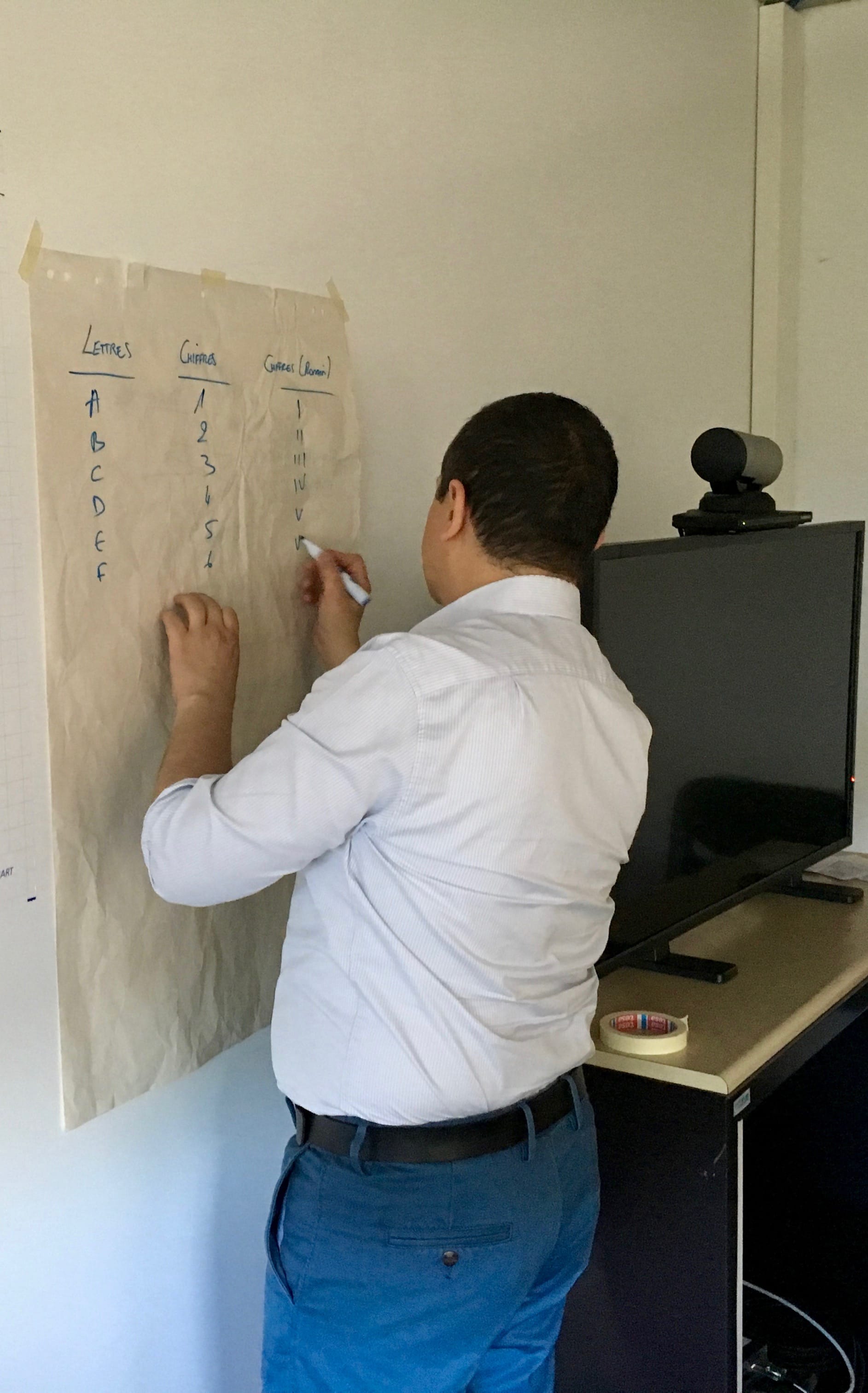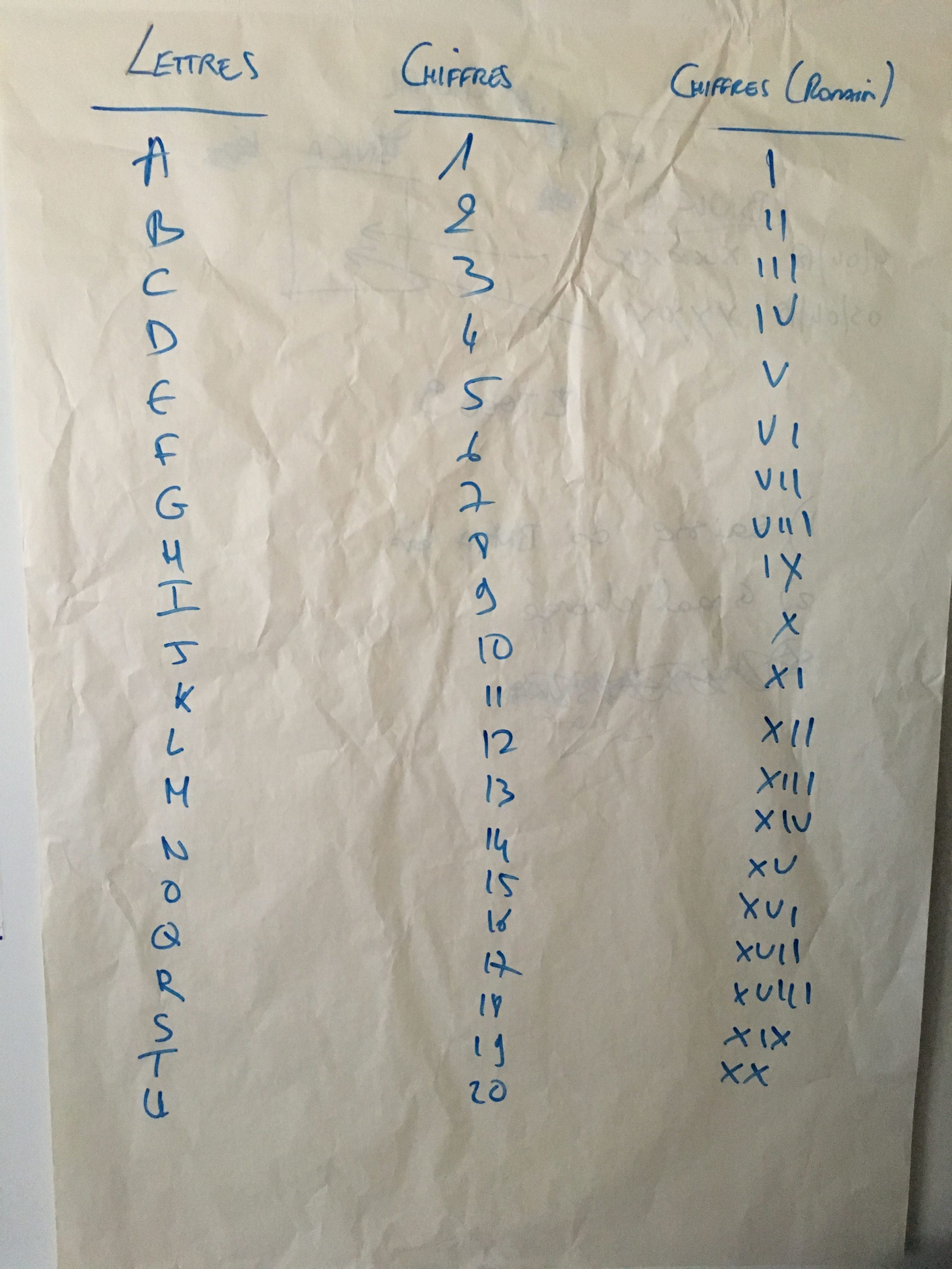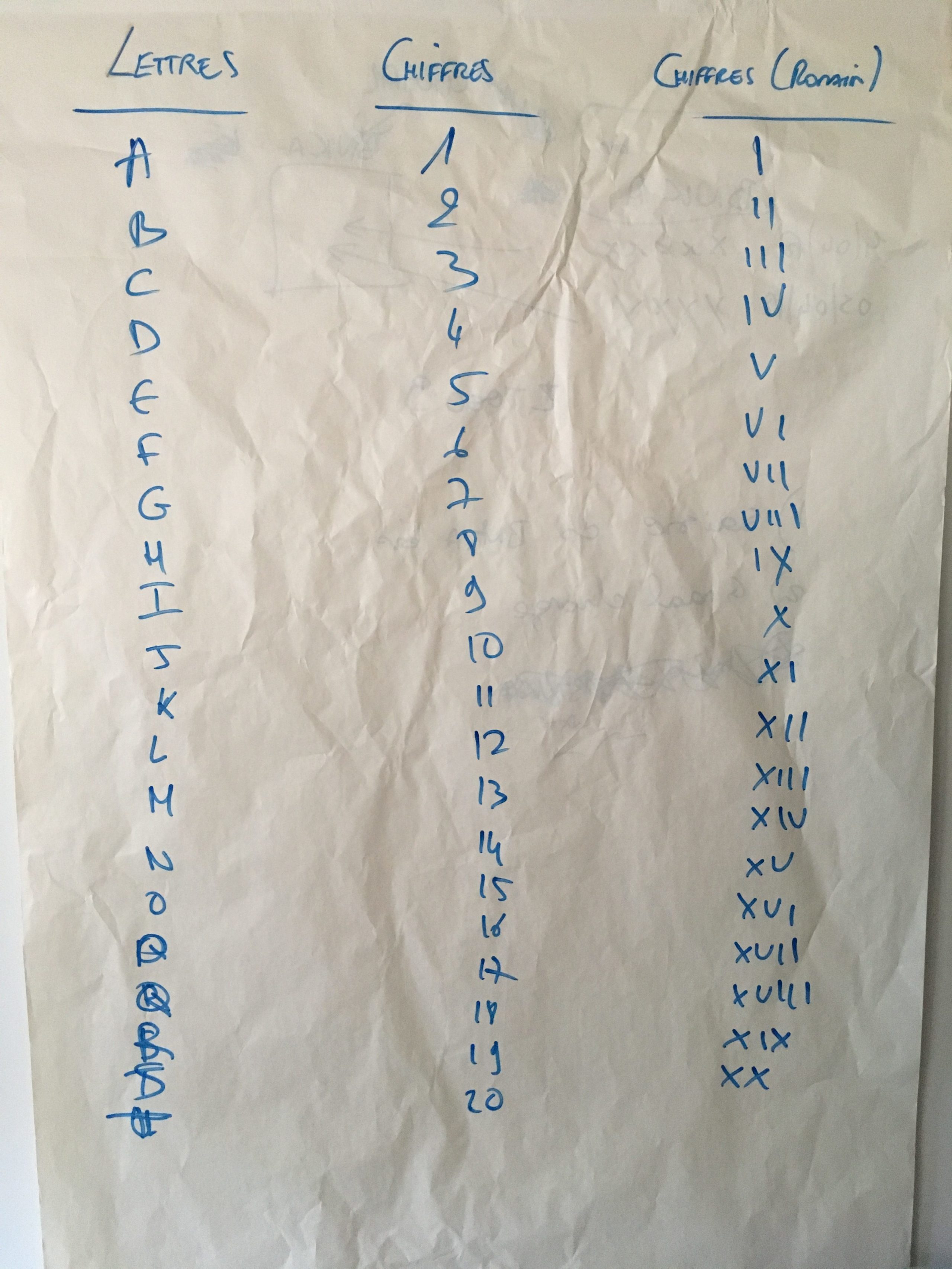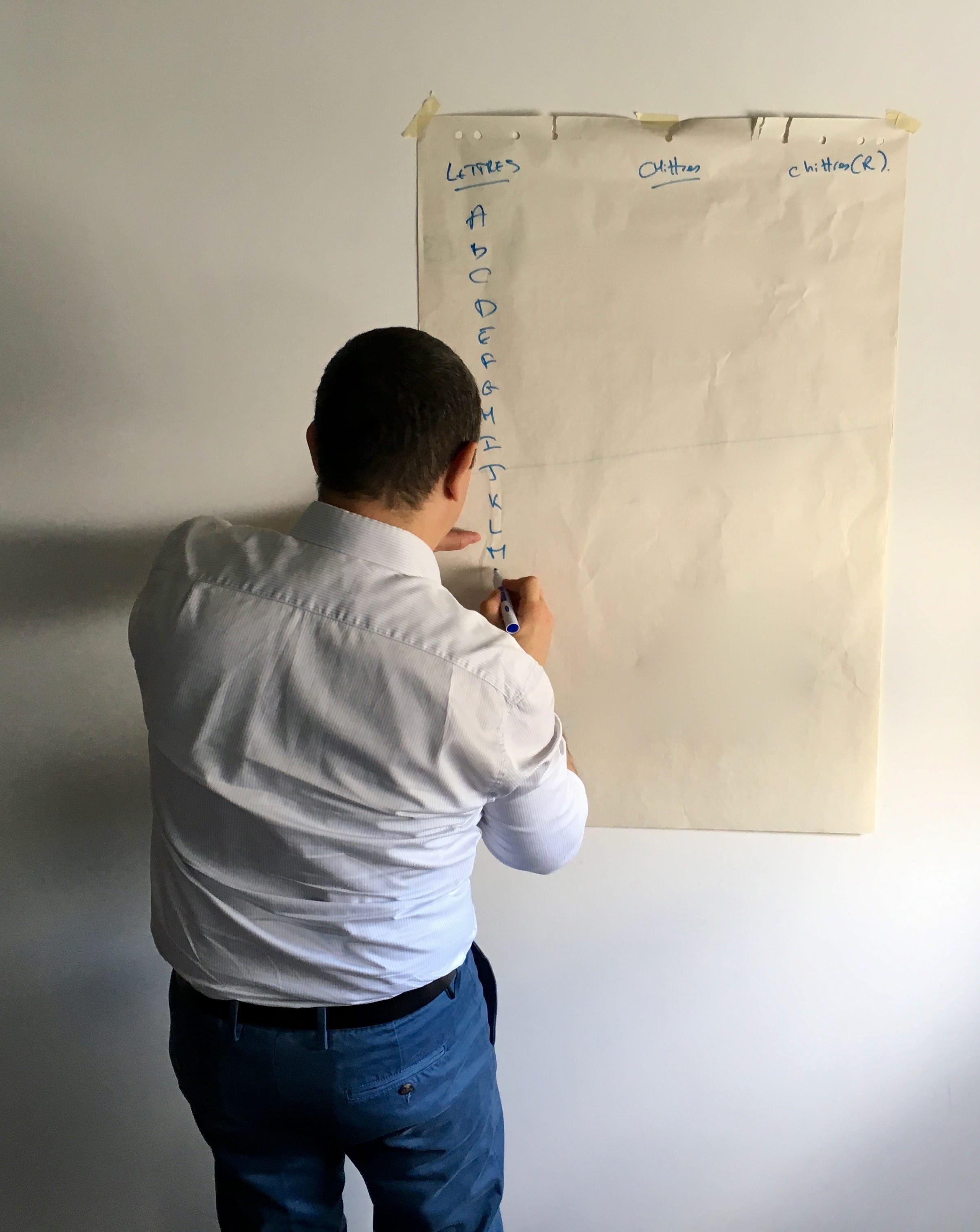
Photo by rawpixel on Unsplash
Au cours d’une réunion avec 3 personnes il y a quelques jours, l’une d’elle m’indique qu’elle travaille sur 3 sujets en même temps et me demande de manière tout à fait sincère : « C’est pas bien ? ». Vous imaginerez bien que j’ai saisi l’occasion pour marteler à nouveau mon « Stop Starting, Start Finishing » favori mais plutôt que de le répéter, autant le faire expérimenter.
J’ai demandé à un de ses collègues de participer à une petite expérience, ce qu’il accepta vaillamment !
Voici ce que je lui ai proposé ! 🙂
Matériel
- Feuille / Paperboard
- Stylo / Feutre
- Chronomètre
Note : vous reconnaissez ici mon souci du moindre matériel ! 😛
Instructions
Ta mission, si tu l’acceptes, va être d’écrire sur 3 colonnes, respectivement :
- Les 26 lettres de l’alphabet
- Les nombres de 1 à 26 en chiffre arabe
- Les nombres de 1 à 26 en chiffre romain
et le tout le plus vite possible bien évidemment !
L’atelier va se dérouler sur 2 tours :
- Tour 1 : l’écriture se fera en switchant de colonne à chaque élément (en horizontal)
- Tour 2 : l’écriture se fera par colonne (en vertical)
Déroulé
Tour 1

Le challenge lancé, nous pouvons commencer à observer ce qu’il se passe.
On peut sentir le balbutiement du cerveau à changer de tâche intellectuelle : il y a une légère pause entre chaque écriture ce qui saccade la réalisation.
Arrivé en milieu de course, sans véritable visibilité sur l’objectif, une sensation d’être perdu survient :
« J’en ai encore la moitié à faire ?! »
Note : Au bout de 10 lettres, je me suis dit que l’exercice était suffisamment long pour obtenir le résultat escompté donc j’ai réduit l’instruction à 20 plutôt qu’à 26.

Rien ne vous choque ?

Et là ? 😛
L’exemple est ici flagrant de la perte de cohérence du travail au bout d’un moment lorsque le multitâche dure trop longtemps.
En effet, gardons en tête que l’atelier nous met ici dans une situation de switch extrême ! 😉
Tour 2

Sans surprises, le tour se déroule plus sereinement.
Le flux d’écriture est continu jusqu’au moment du switch sur la colonne suivante, la focalisation est présente.
Il n’y a donc que 2 moments de latence dans ce tour contre 59 dans le tour précédent.
Étude des temps
| Tour 1 | 1 minute 55 secondes | 115 secondes |
| Tour 2 | 1 minute 08 secondes | 68 secondes |
Nous avons donc une perte de productivité d’environ 40% au tour 1 sous l’effet du switch de tâches.
Pouvez-vous imaginer l’impact de cette pratique sur des tâches créatives complexes lorsque l’on voit le résultat sur des tâches aussi simples que l’écriture de lettres et de chiffres ?
Débriefing
Le débriefing est assez simple car les résultats parlent généralement d’eux-mêmes.
Cependant, je rajouterais quelques éléments supplémentaires :
- Ce que l’on appelle « Multitasking » est en fait une notion qui n’existe pas, car neurologiquement impossible. En effet, le cerveau ne peut traiter 2 choses en même temps mais va passer de l’une à l’autre à une telle vitesse que nous pouvons avoir une illusion de simultanéité. Le terme plus approprié serait donc le « Switchtasking ».
- Le « Multitasking » endommagerait le cerveau
- Le « Multitasking » diminuerait le Quotient Intellectuel
- Plus on sollicite son cerveau, plus on risque de faire des erreurs
- Ceux qui se revendiquent le plus d’être « Multi-tâches » sont en général ceux qui sont en fait le moins doués pour ça
Sources :
- https://www.planzone.fr/blog/pourquoi-multitache-nuit-projets
- http://www.slate.fr/lien/67581/multitache
- http://www.sciencepresse.qc.ca/actualite/detecteur-rumeurs/2017/06/21/cerveau-multitache-mythe-plutot-vrai
Conclusion
Un petit atelier rapide à effectuer qui généralement fait son effet ! 🙂
Note : vous pouvez bien évidemment changer les différentes activités à votre guise, l’idée étant simplement de faire switcher le participant d’une tâche intellectuelle à une autre.
Stop Starting, Start Finishing







4 réponses
Super! Y a aussi un bon article sur cette illusion du multitasking dans le magasine Cerveau et Psycho N°100 par Jean-Philippe Lachaux, qui explique qu’on sait observer biologiquement cette impossibilité de faire 2 tâches en même temps.
Merci Olivier pour l’article, toujours des belles opportunités de remise en cause et d’apprentissage tes articles, j’adore.
Ton atelier me semble intéressant car il permet de prendre consciences des limites du multi tâches. Donc c’est mission accompli. Après, je suis plus prudent sur le débrief. D’un certain point de vue, tu donnes l’impression avec l’atelier que le multi tâches est la raison de l’écart de performance alors que peut être pas tant que ça. En effet, tu demandes dans un premier temps un effort d’apprentissage bien plus important que dans le second cas. Donc, bien sur le multi tâches rend plus difficile la réalisation mais dans le second cas, et par exemple, tu t’appuies sur un comportement ancré et donc l’effort d’apprentissage est bien moindre.
Exprimé autrement, je serais prudent sur l’amalgame créé entre la notion de multi tâches (les tâches que nous faisons dans notre quotidien) et le caractère multi-tâches du cerveau. Si nous peinons à passer d’une tâche à une autre, c’est pour bien plus de raison que la vitesse de switch du cerveau. J’ai cité le fait que le comportement soit précédemment ancré, je rajoute ici la notion de filtre d’attention.
Pour les plus curieux, la notion de multitasking en neurosciences est plutôt traité sous le terme d’attention divisée et s’intéresse à des tâches qui ont lieu en même temps (comme conduire en téléphonant). L’illusion est de penser que nous avons pleinement conscience des deux tâches et pour autant, on ne peut pas rejeter l’idée qu’ à la vitesse de notre conscience nous faisons bel et bien les deux deux choses en même temps. Le gendarme sur le bord de la route constatera bien que vous faisiez les deux (allez lui expliquer le switch du cerveau). C’est donc bien d’attention qu’il est question selon moi. Pour creuser encore, il faut avoir conscience que même dans le cas où nous ne faisons qu’une chose à la fois, les « filtres d’attention » pour vulgariser nous empêche d’avoir pleinement conscience de la « réalité » qui nous entoure. Donc et ce sera ma conclusion, le cerveau propose des phénomènes hautement complexes et il est peut être risqué d’isoler une « raison » possible. Il est tentant de faire un lien entre notre vitesse de switch entre deux tâches et la vitesse de switch du cerveau. Pour illustrer, c’est comme restreindre la capacité d’écoulement du traffic sur une autoroute à la capacité d’ouverture des barrières de péage. C’est un facteur limitant certes mais loin d’être le seul et certainement pas le plus impactant.
J’ai adoré votre article.
Tous les défis que relève au quotidien mon Assistant de projets Taskworld s’y trouve.
Absolument tous.
Y :compris le suivi du temps passé par tâches / listes de tâches / projets / collaborateurs.
J’aimerais connaître vos impressions quant à l’outil : https://taskworld.com/fr/signup/
Qu’en pensez-vous?
Merci pour l’article Olivier! Cela me donne beaucoup d’inspiration. Une variante pourrait d’ailleurs être de timeboxer chaque tour (avec la durée qu’intentionnellement ne permettrait pas de remplir les 3 colonnes). Au premier tour aucune colonne ne seraient remplie et donc pas de valeur produite, alors qu’au 2ème tour une ou deux colonnes seraient bien terminées et donc il y a bien de la valeur produite à la fin de l’itération. Cela permettrait encore une fois mettre en avant ton principe favori “Stop Starting, Start Finishing” 🙂